The holy grail for every content team is to have their company be known for the content that they produce. More specifically, brands want to be able to create a narrative that separates them from their competition.
Some brands have been able to do this successfully, for example:
Drift was able to separate itself from all of the other “chatbots” by creating the concept of conversational marketing and evangelizing it through content.
Clearscope was able to set itself apart from other SEO tools by sharing long-form webinars and videos, where their founder analyzed detailed examples and case studies around search intent, which search queries had overlapping results, and what that meant for on-page optimization and content optimization (what their tool does).
These are two examples of companies that have managed to create a “content brand,” or in other words, a brand that differentiates itself through the content that they produce.
At Grow and Convert, we differentiated ourselves from the commoditized content marketing and SEO world when we coined the term Pain Point SEO. The term is now synonymous with a bottom-of-the-funnel first content strategy and has gained popularity over the past five years.
When companies are able to create a content brand, they benefit from prospects viewing their product or service as differentiated (even if their product or service from a feature perspective isn’t that differentiated). The quality of their content can differentiate their brand and build trust.
The reasoning: Prospects know the brand, like the brand, and trust the brand because of the content, and therefore assume that the product or service must be good, too.
In other words, even if you think all chatbots are the same, you might buy into Drift’s narrative on conversational marketing, and that might make you want to buy their product over the rest of the companies in that category. Or, if you’ve watched a Clearscope webinar with smart insights on SERP analysis, a part of you assumes that those strategies are baked into their product and will also help you to rank well.
Obviously, this is a massive advantage to a brand trying to differentiate itself in a commoditized space.
Additional benefits of creating a content brand:
- Prospects come in educated and have already bought into what you do
- Sales cycles are shortened
- You reduce the number of competitors that prospects are considering
In this article, we’re going to share what a content brand is and how we think about creating one.
What Is a Content Brand?
A content brand is a company that has been able to differentiate itself, grow awareness, and change the perception of its business through content. Oftentimes content brands are in categories that are heavily commoditized, but a big reason they stand out is because of the content that they produce.
Examples of B2C content brands are Redbull, Yeti, Nike, Liquid Death, and Patagonia.
Examples of B2B content brands are HubSpot, Drift, Gong, Moz (via Rand Fishkin), and Basecamp.
Notably, most of the examples we listed are larger brands. We’ve noticed that smaller brands either don’t try or struggle to execute in building a content brand.
Why?
We think it’s because there’s an important precursor to successfully building a content brand: a crystal clear understanding of your positioning.
The Foundation of Building a Content Brand: What Makes Your Company Unique?
Step one in creating a content brand is understanding the reasoning behind what makes your company unique, or in other words, your positioning.
This isn’t just about what features your product has that others don’t have. It’s bigger than that. It includes elements of why you exist, what hole in the market you fill, and how you make your customers’ lives better.
To figure out what makes you unique, these are the sorts of questions you need to ask yourself (or your customers):
- Why was your company created?
- What’s different about the strategic approach you take vs. the way that everyone else in the industry does things?
- Does your product or service have any unique features that other businesses don’t have?
- Do you approach solving any problems in your business in a unique way?
- Does much of your industry believe in something you think is wrong or false?
We ask every single client questions like these in our sales conversations and in extensive interviews at the start of the engagement because we also need to deeply understand their positioning in order to pitch their brand at a high level in their content. And we’ve found that these questions do a great job in developing concepts that differentiate a brand from its competition. They often lead to lively discussions that reveal that different folks at the company even have disagreements on these answers, and they’re forced to do the hard but rewarding work of resolving those differences.
The answers to these questions will be the foundation or the seedlings of the core concepts that we discuss below. They’re the original seedlings of how your brand is different or what you’re disrupting or changing that’s broken in your space. These ideas will lead to the foundational content pieces that will differentiate your brand.
Case Study: Figuring Out What Makes Grow and Convert Unique
Here’s an example of what answering these questions can lead to from our own positioning case study. This is a summary of the problems we set out to solve that were rampant in the content and SEO marketing agency world.
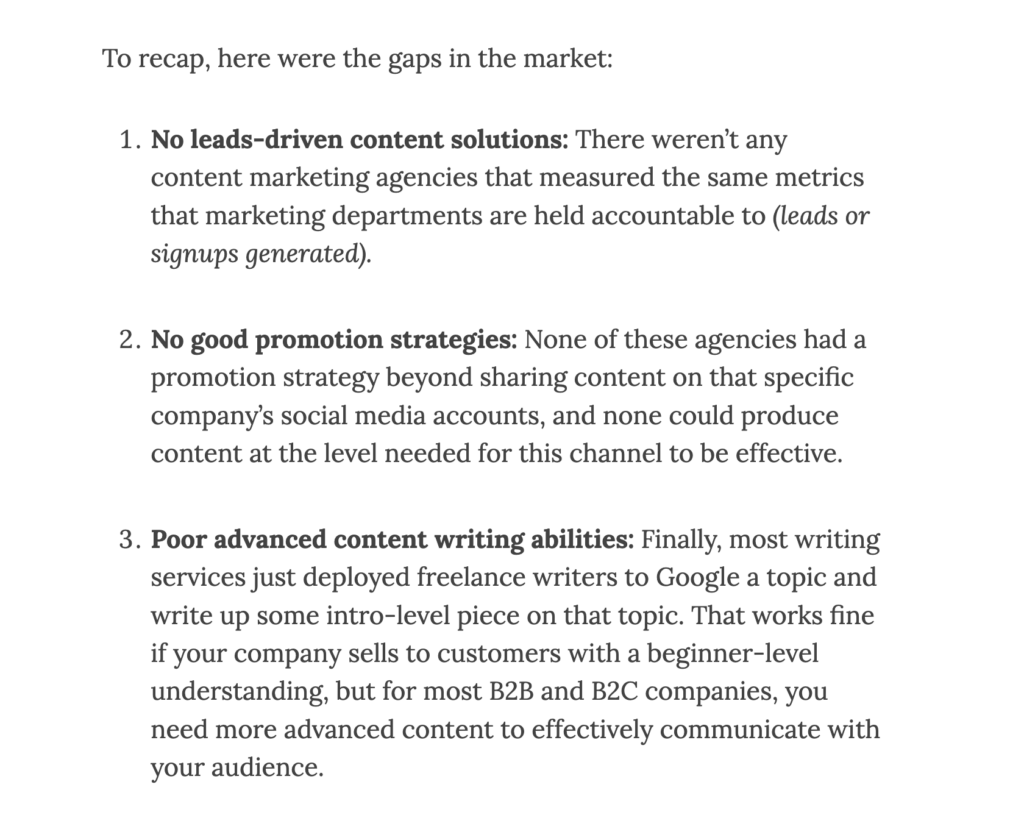
In short, agencies weren’t good at measuring or holding themselves accountable to leads generated, they often didn’t promote the content they produced (and if they did, they just shared from social accounts without any real strategy), and content production was farmed out to freelance writers that had no experience on the topic they were writing about. All of these things led to subpar results.
Our solution to the above three problems was to create an agency that (1) held itself accountable to leads generated, (2) actually promoted the content it produced, and (3) could write on very advanced topics in wide-ranging fields (such as concussion and cancer treatment and software development) because we interview subject matter experts inside of the business rather than farm out writing to people that don’t have expertise on a topic.
Having a clear understanding of what separates your business from its competitors is what allows you to create core concepts for your brand that all of your content ties back to.
Coming Up with Core Concepts for Your Brand
We think that every business has around 3–5 core concepts that are unique to them. (At the start, it may be just one or two, which you can build on over time.)
These core concepts are your “thought leadership” — concepts that push the thinking in your industry forward. These are opinions, stories, data, and/or strategies that share how you approach solving a problem core to your industry that’s different from the way that everyone else does things.
You formulate these core concepts over time as you start to come up with ideas that truly set yourself apart from the way others are doing things. These concepts should map to the problems you solve in the section above. Almost every business should have some sort of differentiation. It doesn’t necessarily have to be from a feature perspective, but it can be a philosophical difference in the way that you approach things, a strategic difference, a process difference, or a cultural difference.
We’ll use Grow and Convert as a running example throughout this post because we feel that most people reading this are familiar with our company, so it should make it easy to understand.
Grow and Convert’s Core Concepts
Pain Point SEO (Strategic Difference)
We came up with Pain Point SEO when we were trying to figure out how to drive more leads from the content we produced for our clients. If we hadn’t initially set out to solve the problem of lead attribution of content marketing, we might not have come up with this strategic difference.
After measuring and figuring out what the highest converting articles we published on behalf of clients were, we noticed that posts that ranked for search queries that had high buying-intent had the highest conversion rates. Contrary to industry norms that prioritized top-of-funnel content, keywords with high volume, and an idea of not selling too much in content, we realized that producing more articles around these bottom-of-the-funnel, high buying-intent keywords (that pitched the client’s product) produced results much faster than the typical top-of-funnel approach. This core concept differentiated us strategically from the way most businesses did content marketing.
Pain Point Copywriting (Process Difference)
Pain point copywriting came from us trying to solve the problem of how to write advanced content that converts for our clients’ businesses. The industry norm for agencies is to hire a bunch of freelance writers, send them a topic and/or content brief, have them self-research the topic, and then write the article. This leads to content that doesn’t sell the value props of your product or service and a lot of surface level content that’s the same as what everyone else writes. The difference in our ability to write advanced content has to do with our process. We interview subject matter experts inside of businesses and use their expertise to write product-focused sales copy.
Content Distribution Strategy (Strategic and Process Difference)
We came up with this differentiator when trying to figure out the best way to drive targeted traffic for our clients. Many agencies just published content and then waited for content to rank. Or, they’d schedule some tweets or LinkedIn posts in Buffer. We figured out an approach to content promotion that was different from how most agencies or in-house brands were doing it, and we shared the strategy in this blog post.
Content Brand (Philosophical and Strategic Difference)
This post is meant to be a core concept for Grow and Convert going forward. There are many companies looking to distinguish themselves with content, but few know how to produce thought leadership content. We created this article to guide people through a framework to produce content that differentiates themselves from their competition.
You can see that all of our core concept examples map to our positioning differences. These articles share how we approach things differently than the status quo and back our core thesis up with evidence, data, stories, and examples that prove the concept to be true.
The next part of building a content brand is to produce supporting content that maps back to these core concepts.
Produce Content That Maps to Core Concepts
Once you’ve come up with a core concept, you need content that explains and supports that core thesis.
You should produce case studies, data posts, strategy guides, and more that help prove the validity of your core concept.
For example, if you look through a bunch of our case studies or strategy articles, you’ll see that they all serve to show how Pain Point SEO was implemented in different types of businesses.
Even large data pieces like this recent analysis of SEO conversion rates adds a ton of original data backing our Pain Point SEO approach. We could’ve just analyzed SEO conversion rates broadly, but instead we chose to tie the conversion rates to the content frameworks we share in our post on Pain Point SEO.
A piece like this not only supports our Pain Point SEO core concept, but it’s unique. (Most other sites in the content marketing space aren’t publishing data on conversion rates across 90+ posts; it’s hard to find data like this.) It’s also extremely hard to replicate since you can’t just hire a freelance writer to go publish a post like this one.
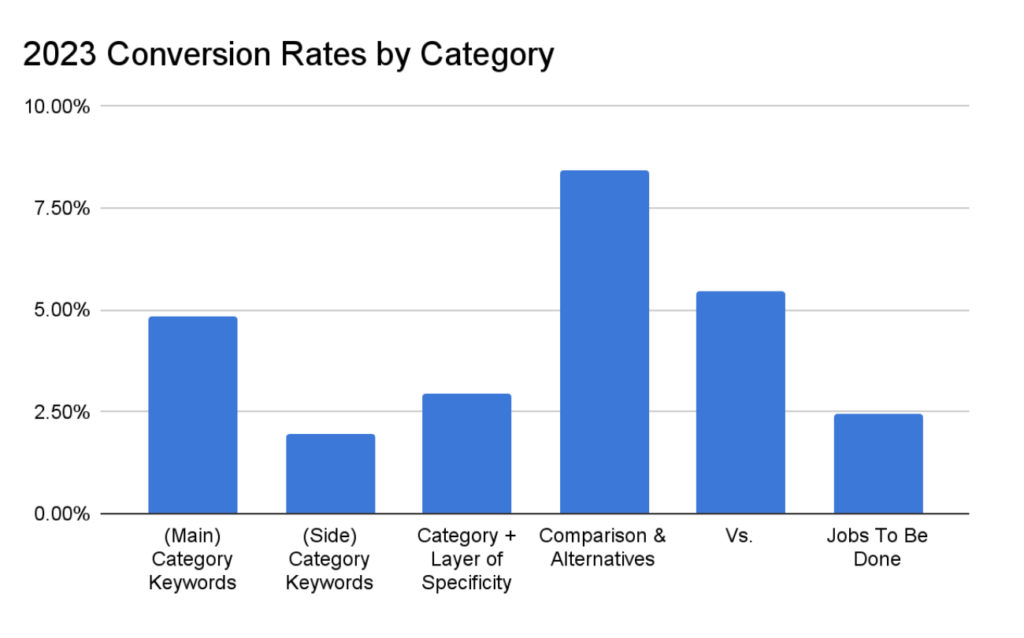
What we’re trying to do here is to provide further proof that our core concepts are a better way to approach things than the status quo or industry norms and that we best understand (or are leading the way on) this core concept in our industry.
Also, original, hard-to-replicate content that maps to your core concepts like this is what starts to get your brand known for its content. In this case, people will start to know that if you want detailed analysis content and SEO conversion rates, you go to Grow and Convert.
Examples of Drift Content That Supports Conversational Marketing
Let’s also look at some of Drift’s content that backed their conversational marketing core concept.
First off, Drift wrote a book on conversational marketing which outlines their core concept. This is the equivalent of our post on Pain Point SEO; it just goes way more in depth.
Drift started a State of the Conversational Marketing Report that surveyed 503 B2B companies to find data and trends on how people benefitted from conversational marketing.
You can find some of those here:
When you create a state of the industry report and use your own branded term to share the data, it’s hard for other companies to argue that they do the same thing.
Not only did they do that, but they also developed a conversational marketing certification program. Again, if you’re certifying people on conversational marketing, it’s going to be hard for someone who has gone through that program to want to buy another tool because they won’t think that the other tool does “conversational marketing,” even if the tool is the same from a feature perspective.
Lastly, Drift has created a number of case studies and JTBD pieces that share how companies have successfully implemented conversational marketing into their sales process.
All of these supporting pieces build on the case for why companies should sell with conversational marketing and follow the Drift process rather than use another tool that has a similar feature set.
Examples of Clearscope Content That Supports Conversational Marketing
I want to include Clearscope examples because they’re different in two ways from us and Drift.
- They’ve developed a content brand without creating a branded concept like “pain point SEO” or “conversational marketing.”
- Their content goes beyond written content and includes a heavy dose of webinars and video.
Clearscope founder Bernard Huang has really compelling beliefs that he shares in webinars about how Google’s algorithm figures out search intent and what content to rank. Then, he supports it with data, analysis, and examples. These beliefs are the basis for how the Clearscope tool was built and why it gets rankings better than other tools that help with on-page SEO.
Essentially, if you buy into what he’s saying in his videos about how search works and why you should create content in specific ways, then you’ll also buy into his tool being able to help you get results from SEO.
Here are some examples of webinars he’s done:
- How to rank SEO content in the era of generative AI
- How to get your content to rank for keywords you’re targeting
They also have written content that supports the idea of ranking on the first page of Google:
While Clearscope uses a different approach than the two examples above (both Grow and Convert and Drift), if you’ve read or watched any of their content, you probably immediately bought into their strategic difference and the value of using Clearscope over many of the other tools that do similar things.
How to Integrate the Content Brand Framework with Your Existing Content Strategy
The content brand framework and your existing content strategy should go hand in hand. The idea is to create a number of pieces around core concepts that are not SEO focused but that can be promoted via paid social (Twitter, LinkedIn), shared through newsletters, and shared through organic social.
Then, you can create supporting pieces that help build on that core thesis. The content type doesn’t matter. You can create YouTube videos that are focused around SEO keywords, webinars, a podcast, eBooks, or pain point SEO focused articles like we do.
The key to differentiating yourself as a content brand is having something unique to say. Hopefully, the content brand framework will help you discover your company’s uniqueness.
How We’re Helping Clients Build Content Brands
We help clients build content brands in two of our services.
First, in our core content service, when it makes sense, we often start the engagement off by publishing a disruption story that is not SEO based (it doesn’t target any SEO keyword) but rather explains what the company and product or service is disrupting. It’s the equivalent of our Pain Point SEO piece or a blog post version of Drift’s Conversational Marketing book. Then, the majority of the SEO-focused pieces we publish after that in our standard engagement harken back to the disruption story and its core concepts. That way, our SEO pieces build this foundation of organic traffic that helps lead prospects that are Googling various high buying-intent phrases to a core concept of the brand.
Here are some examples of disruption stories that we’ve produced:
Rainforest QA
Rainforest QA is a client who has a really innovative product in the software quality assurance (QA) space. Most QA is done using code-based software, so it has to be managed and run by developers. Their product is visual, so other departments can own the QA process as well. This piece talks about how that concept can transform product development processes for the better.
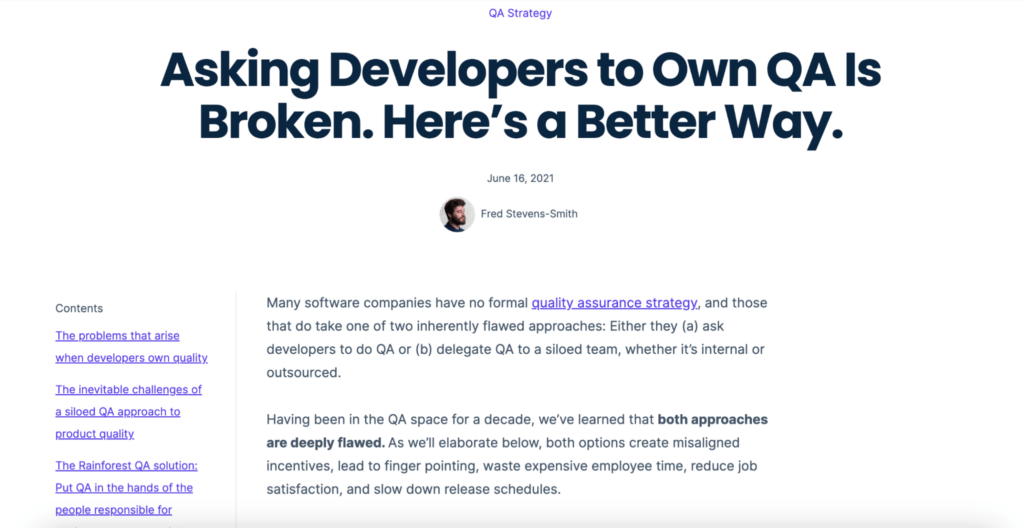
Asking Developers to Own QA Is Broken. Here’s a Better Way.
Vocal Video
Vocal Video has built a really easy-to-use software for collecting video testimonials. Instead of hiring a video production crew and meeting on-site somewhere, marketing teams can send happy customers a single link that allows customers to walk through a simple guided process to record their thoughts using their own phone or computer camera. This piece goes into what that ease of producing testimonial videos enables for marketing teams.
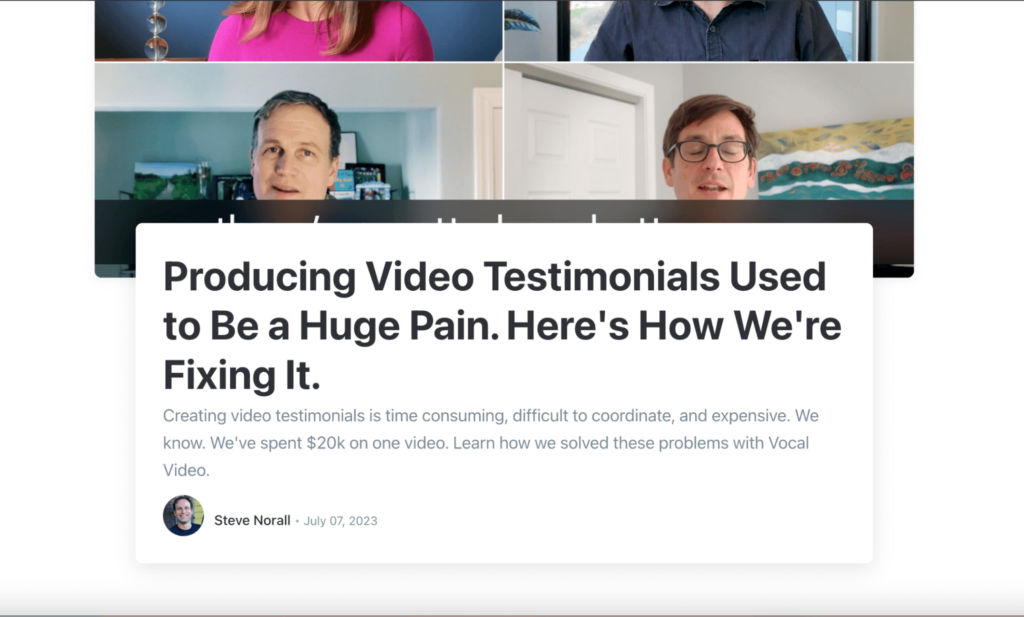
Producing Video Testimonials Used to Be a Huge Pain. Here’s How We’re Fixing It.
Lawclerk
Lawclerk is a marketplace of lawyers available for other law firms to hire when they need extra legal help. That sounds simple, but behind the idea is some really provocative thinking around how the business model of large law firms is broken. Here, we helped Greg German, a co-founder of Lawclerk, get those ideas across via their founding story. Note how the piece also sells Lawclerk in addition to the commentary on large law firm business models and their issues.
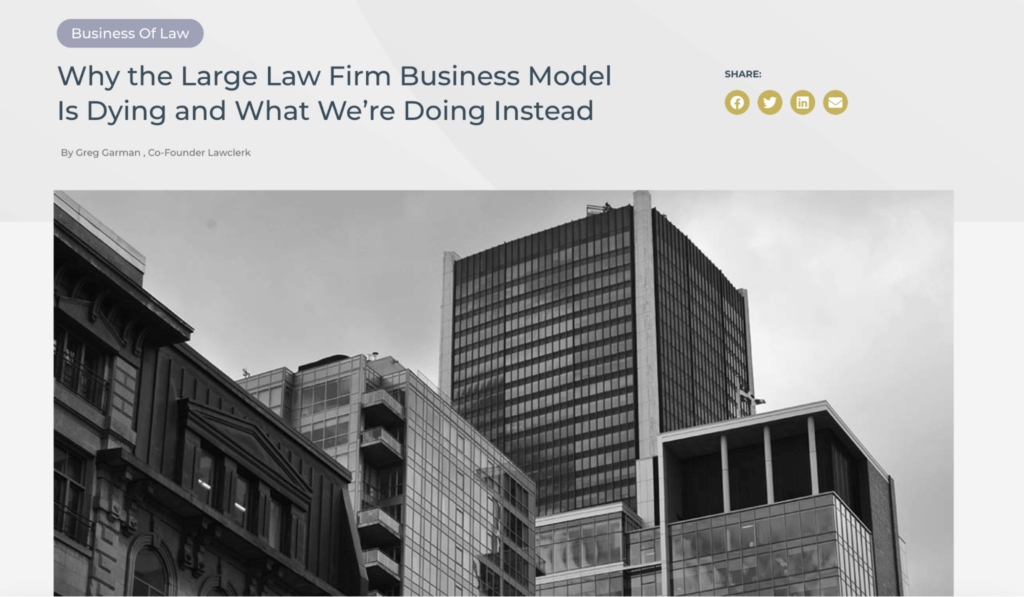
Why the Large Law Firm Business Model Is Dying and What We’re Doing Instead
Second, we also offer a one-time project based engagement where we help brands figure out their foundational core concept(s) and positioning via interviews. We expand upon the questions above to uncover what the brand is disrupting, what differentiates them in their space, what core customer pain points they are solving, and more. Then, we publish one or two disruption story pieces that convey that core concept in an engaging and educational way. You can learn more about this service here.








